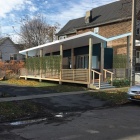The UB Affordable Housing Initiative
Imagining. Innovating. Building.

Students work on a recent affordable housing rehab project in Buffalo.
Although the City of Buffalo has experienced a resurgence, it has inadequate high-quality housing that is affordable to a significant portion of its population. Like many cities, affordable housing in Buffalo has been heavily dependent on the availability of investments through low-income housing tax credits, the future availability of which is uncertain.
In 2018, the School of Architecture and Planning recently gathered more than 150 leaders in affordable housing to consider policy, design and building solutions to an issue that has reached crisis proportions in cities across the U.S. The symposium kicked off a new program at the school to design and build affordable housing prototypes for Buffalo and cities like it across the U.S.
For over 50 years, the school has made practical work in, with and for communities in Buffalo and the upstate region a central experience in the education of student architects, planners and real estate developers.
Through coursework, research and participation in studios, architecture, real estate development and urban planning students and faculty will plan, design and ultimately build single-family or multi-family housing prototypes for underserved neighborhoods on Buffalo's East or West Side. Prototypes will be replicable both for Buffalo and cities like it across the U.S. The design-build project will also consider innovative design and construction materials and techniques.
Faculty publications and student work on affordable housing
Donald Capoccia: Founding Supporter of UB's Affordable Housing Initiative

Donald Capoccia shows students his Essex Crossing mixed-use and affordable housing development in New York City.
A developer with more than 30 years in New York City's affordable housing market, Donald Capoccia is an inspired community-builder. A 1978 graduate of UB, he came to the school with an interest in supporting hands-on research to develop new models for high-quality affordable housing. We thank Don for his vision and leadership of a program that will enrich the learning experience for our students, rethink affordable housing, and improve communities.
Thank you to the following generous supporters of UB's Affordable Housing Initiative:
Don Capoccia ’78 | Tim Dempsey ’94 | Franklin Dickinson ’85 | Scott Lesh ’95 | Alex Morris ’91, ’94 | Cannon Heyman & Weiss | LVMH Moet Hennessy Louis Vuitton | Anonymous
















